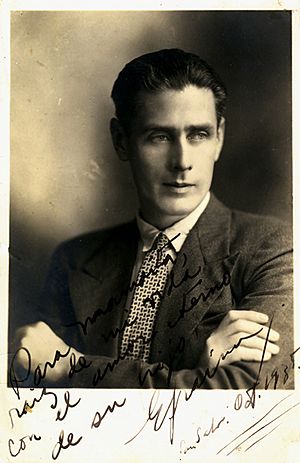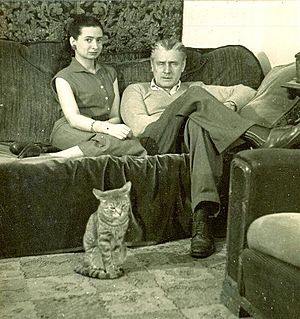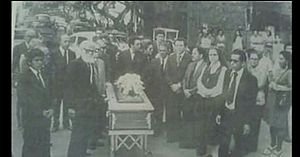Salarrué facts for kids
Quick facts for kids
Salvador Efraín Salazar Arrué (Salarrué)
|
|
|---|---|

Salarrué
|
|
| Born | Salvador Efraín Salazar Arrué October 22, 1899 Sonsonate, El Salvador |
| Died | November 27, 1975 (aged 76) Planes de Renderos, El Salvador |
| Occupation | Author, editor, painter, diplomat |
| Spouse | Zélie Lardé |
Luis Salvador Efraín Salazar Arrué (born October 22, 1899 – died November 27, 1975) was a famous writer, poet, and painter from El Salvador. He was known by his shorter name, Salarrué, which came from his last names.
Salarrué was born in Sonsonate to a family that had enough money. He studied painting at the Corcoran School of Art in Washington, D.C. from 1916 to 1919. After his studies, he went back to El Salvador.
In 1922, he married Zélie Lardé, who was also a painter. They had three daughters together.
In the late 1920s, Salarrué worked for a newspaper called Patria. It was owned by Alberto Masferrer, an important thinker from El Salvador. To fill empty spaces in the newspaper, Salarrué wrote many short stories. These stories were later put together in a book called Cuentos de Cipotes, which means "Children's Stories."
His books Cuentos de Cipotes and Cuentos de Barro ("Tales of Clay") became his most loved works. They showed an ideal picture of life in the countryside of El Salvador. These stories made him one of the first writers to create a new style of Latin American folkloric storytelling.
Many readers did not fully understand how clever the stories in Cuentos de Barro were. Salarrué used a special and creative way of writing. This allowed him to talk about a difficult time in El Salvador's history, including a violent event in 1933. He did this without the leaders of the time understanding that he was writing about them.
Salarrué lived in the United States from 1947 to 1951. During this time, he worked for his country as a diplomat. This means he represented El Salvador in another country.
He passed away in Los Planes de Renderos, which is near San Salvador. He is buried in the Cementerio de los Ilustres, also known as the "Cemetery of Distinguished Citizens."
Early Life and Education
Childhood in Sonsonate
Luis Salvador Efraín Salazar Arrué was born on October 22, 1899. He grew up on a family farm in the El Mojón area, which is now part of Sonzacate in Sonsonate. His early years were spent surrounded by the beautiful nature of Sonsonate.
Even as a child, Salarrué was a bit shy. He preferred inventing stories over rough games. When he was eight, his mother faced money problems. This meant young Luis had to move between his home in San Salvador and Santa Tecla.
School Days
Luis Salvador went to elementary school at Liceo Salvadoreño. He then attended high school at Instituto Nacional de Varones. Later, he went to Academia de Comercio, but he did not finish his studies there. Even so, he always got good grades.
His talent for art showed early on. When he was just 11, one of his writings was published in the Diario de El Salvador newspaper. This was a big achievement and showed his connection with local writers.
Main Works
Salarrué wrote many books and stories. Here are some of his most famous works:
- El Cristo Negro (The Black Christ) (1926)
- El Señor de la Burbuja (The Lord of The Bubble) (1927)
- O Yarkandal (1929)
- Remotando el Uluán (Remoting the Uluan) (1932)
- Cuentos de Barro (Clay Stories) (1934)
- Conjeturas en la Penumbra (Conjectures in the Twilight) (1934)
- Eso y Más (That and More) (1940)
- Cuentos de Cipotes (Children Stories) (1945)
- Trasmallo (1954)
- La Espada y Otras Narraciones (The Sword and Other Narrations) (1960)
- Vilanos (1969)
- Ingrimo (1969)
- La Sombra y Otros Motivos Literiarios (The Shadow and other Literary Motifs) (1969)
- La Sed de Sling Bader (Sling Bader's Thirst) (1971)
- Catleya Luna (1974)
- Mundo Nomasito (Poetry - 1975)
See also
 In Spanish: Salvador Salazar Arrué para niños
In Spanish: Salvador Salazar Arrué para niños



